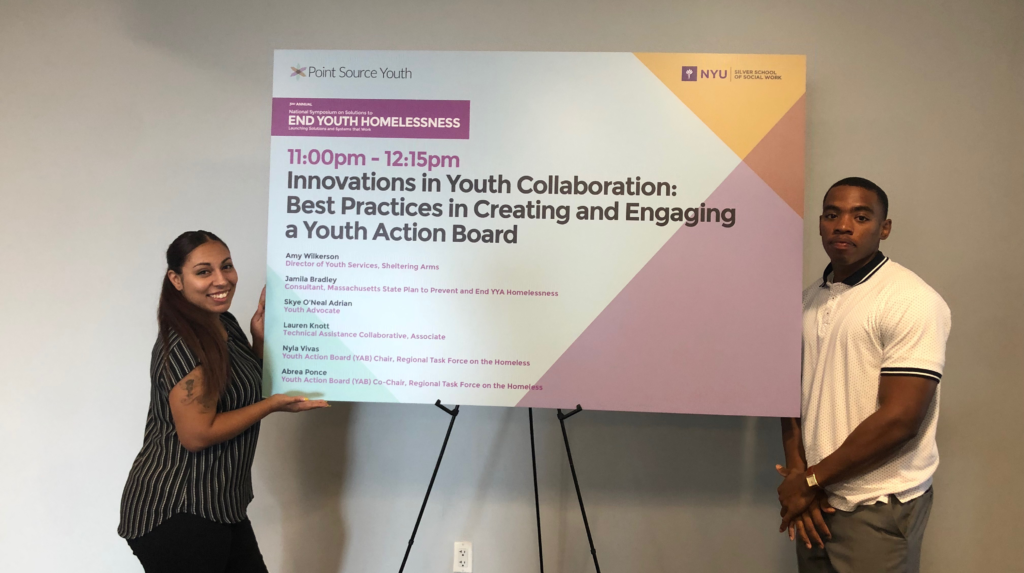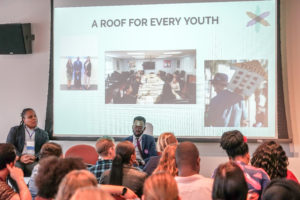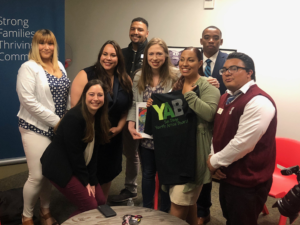
More than 3.5 million young adults in the U.S. experience homelessness each year. In an effort to create space to share tools, resources and tangible solutions for individuals to get housing and other services they need to flourish in life, Point Source Youth—a national organization dedicated to ending youth homelessness in 50 cities in 10 years—hosted the Annual National Symposium on Solutions to End Youth Homelessness.
Over 850 people attended the symposium this June in New York, New York; including San Diego Workforce Partnership Business Partnerships Specialist Dimitri Smith, who serves on the San Diego Youth Action Board (YAB), a diverse and resilient group of currently and formerly homeless youth working to end youth homelessness. Here Dimitri shares his perspective and takeaways from the event.
“Nothing about us, or for us, without us!”
The opening remark came directly from a youth advocate. As the crowd erupted in applause, they repeated the statement as if it were a battle cry. I strongly believe in centering the voices of the young people you intend to serve, and I am proud to say that the power of this conference came directly from the mouths of youth who have been previously impacted by the struggles and barriers of homelessness.
Homelessness does not discriminate
The U.S. Department of Housing and Urban Development (HUD) reported that San Diego’s homeless population is the fourth-highest in the nation, a position the county has held since 2015. Twelve percent of the total homeless population in San Diego County are young adults under the age of 24.
Ultimately, youth of all sub-populations are suffering with housing insecurity but especially LGBT+ youth and youth of color.
Many of these young adults have been victims of human trafficking, domestic violence and victimization as a whole. Many of the sessions held by the event were aimed towards shifting housing projects to be more innovative when serving youth and meeting their individualized needs. Another big component was learning how to be effective when housing youth to support them while they become the best version of themselves.
“It is extremely difficult to see yourself get out of being homeless when you’re experiencing homelessness,” said Mahlon Randolph, youth advocate and symposium speaker.
Many communities are implementing the Host Home Model, which is very similar to a foreign exchange student living situation, and are finding this to be an innovative and effective strategy.
 Housing requirements add unnecessary barriers for youth
Housing requirements add unnecessary barriers for youth
Why isn’t being homeless enough for someone to qualify for housing? Why is it that we feel the need to create more barriers for people trying to access housing? Historically, you would have to be “housing ready” for a housing resource but now HUD has pushed to create a system where anyone and everyone is housing ready.
Housing First, just as it sounds, is an approach to quickly and successfully connect individuals and families experiencing homelessness to permanent housing without preconditions and barriers to entry, such as sobriety, treatment or service participation requirements. Housing with no preconditions—meaning it is not required that a young adult comes in sober, through a program, is employed or in school, etc. to obtain housing is crucial because the pathway to success for youth experiencing homelessness begins with housing; the rest will follow.
“We create systems around people instead of creating them with people,” remarked Lamont Green, Senior Policy Analyst, City of Tacoma Office of Equity and Human Rights.
We as advocates and service providers have to do something that has never been done before if we want to diminish youth homelessness. This is why a Housing First policy is critical to getting young adults experiencing homelessness stabilized and on the right path to success and permanency.
Youth deserve meaningful, empowered and COMPENSATED seats at the table
Young adults are the subject matter experts of their own lived experiences. We have been treating them as volunteers when we should compensate them (Nothing for us or about us without us!). We have to create a space for young people to shift our systems in the direction we need it to go. Adultism is systematic discrimination against young people. They are often seen as too ignorant about life and the world to make their own decisions. It is time to flip the script and realize the return on investment of youth buy-in for our programs in order to have an impact.
As a member of the YAB, a subcommittee of HUD’s Continuum of Care program, I understand the importance of prioritizing housing for homeless youth. We work with and alongside the Regional Task Force on the Homeless, stakeholders, governmental agencies and homeless providers.
 San Diego was awarded the largest amount in the nation from HUD ($7.94 million) to develop a coordinated ecosystem of housing and supportive services to prevent and end youth homelessness for over 1,000 young adults over the span of two years. This dedicated group of youth and young adults created a coordinated community plan over the course of nine months in hopes of eradicating youth homelessness in San Diego. This project was led by youth and focused on youth to ensure youth voice was present for all decision making.
San Diego was awarded the largest amount in the nation from HUD ($7.94 million) to develop a coordinated ecosystem of housing and supportive services to prevent and end youth homelessness for over 1,000 young adults over the span of two years. This dedicated group of youth and young adults created a coordinated community plan over the course of nine months in hopes of eradicating youth homelessness in San Diego. This project was led by youth and focused on youth to ensure youth voice was present for all decision making.
Due to the hard work YAB has been doing in San Diego, co-chairs Abrea Ponce and Nyla Vivas were invited to speak on the Innovations in Youth Collaboration panel at the symposium where attendees heard how youth advocates and providers across the country are collaborating on the movement to end youth homelessness using an equity framework.
We would be doing a disservice to our community and our fellow young adults to continue spending millions of dollars designing and funding programs and systems for young people without them at the table.

